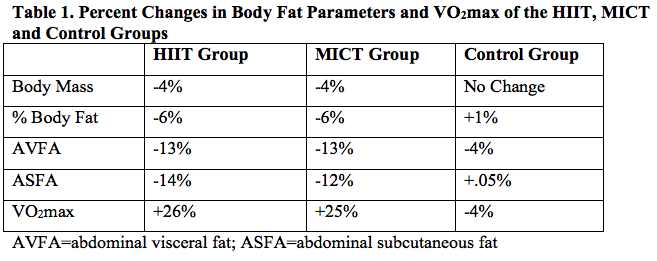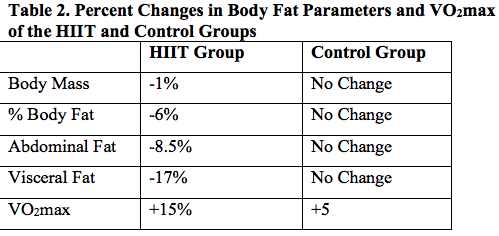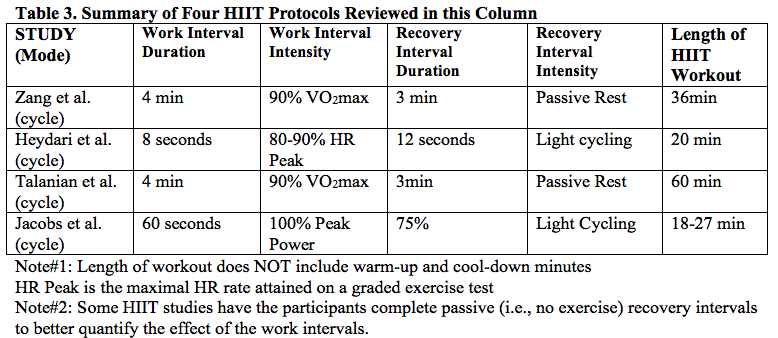HIIT Training for Fast, Efficient Fat Loss
Len Kravitz, PhD
Introduction:
Obesity is an increasing global health challenge that poses a risk for cardiovascular disease, type 2 diabetes, metabolic syndrome and all-cause mortality (Zhang et al., 2017). More specifically, central adiposity (i.e., visceral fat), which is the fat tissue around the major organs in the torso, enhances the risk of chronic diseases (Zhang et al.). There is plenty of research that shows high-volume, moderate intensity exercise is an effective intervention for reducing central obesity (Zhang et al.). However, until recently, little has been known about the influence of high intensity interval training (HIIT) on weight and/or fat loss in women and men, which is the focus of this month's research column where we review two new studies.
Study 1. Zhang, H., Tong, T. K., Qui, W. et al. (2017). Comparable effects of high-intensity interval training and prolonged continuous exercise training on abdominal visceral fat reduction in obese women, Journal of Diabetes Research, 9 pages, doi.org/10.1155/2017/5071740
Purpose: The purpose of this article was to determine the effect of moderate-intensity continuous exercise (MICT) versus HIIT on reducing whole-body, abdominal visceral, and abdominal subcutaneous fat in a 12-week training study with obese young women.
Participants: Forty-three healthy Chinese female participants (18-22yrs of age, BMI &Mac179;25 kg/m2; % body fat &Mac179; 30) were randomly assigned to a HIIT group (n=15), MICT group (n=15) and no-training control group (n=13). Participants did not do any other form of exercise training during the study.
Training Protocol: For the first 4 weeks of the study both the MICT and HIIT group trained 3 days a week. For weeks 5 through 12 both groups trained 4 days per week. Quite uniquely, using continuous gas analysis collection during each exercise trial, the researchers matched the energy expenditure for each exercise session of the participants in both exercising groups. For example, during the first 4 weeks both groups performed exercise training sessions that expended 200 kilocalories per workout. During weeks five through 12, both exercise groups expended 300 kilocalories per session. The MICT group performed continuous steady state exercise on a cycle ergometer at a comfortably hard intensity at 60% VO2max. Also using a cycle ergometer, the HIIT group performed a 4-min hard intensity (90% of VO2max) followed by a 3-min passive recovery until each subject reached the targeted kilocalorie expenditure for that workout. At the end of the 4th and 8th week the researchers reassessed the participants' VO2max to make sure the training intensities reflected their increasing level of fitness. All workouts began with a warm-up and finished with a cool-down. All participants also recorded daily dietary intake during the study, which was evaluated by a dietician. This was completed to make sure none of the participants choose to go on a diet, which would have skewed the study results.
Results/Discussion
Body mass, % body fat, abdominal visceral fat (AVFA) and abdominal subcutaneous fat (ASFA) were measured using dual energy x-ray absorptiometry and computed tomography. Results of the study are shown in Table 1. The HIIT and MICT group have virtually the same significant changes in all measured body fat parameters, with no changes observed in the control group. Interestingly, since the researchers matched energy expenditure of all workouts (~300 kilocalories), the MAJOR significant difference observed between the HIIT and MICT groups was in the duration of each workout. The average time to complete the workout sessions during weeks 4-12 was 36 minutes for the HIIT group as compared to 68 minutes for the MICT group. In addition, the HIIT group attained the same improvement in VO2max as the MICT group in 50% less exercise time. Although the mechanisms why the HIIT group attained similar results in a much shorter time period are not fully clear, the authors propose that it has been shown that HIIT workouts have been shown to have an elevated post-workout metabolic rate (referred to as excess post-exercise oxygen consumption or the exercise 'after-burn'). In addition, the researchers submit that high intensity exercise has been confirmed to activate major hormones (epinephrine, norepinephrine, growth hormone) involved in fat metabolism.
Major Take-Away: In obese, sedentary women, a 12-week HIIT program of 4-min work alternating with 3-min passive recovery attained comparable body composition and aerobic capacity results in half the amount of time it took for a continuous exercise group.
Study 2. Heydari, M., Freund, J. and Boutcher, S.H. (2012). The effect of high-intensity intermittent exercise on body composition of overweight young males, Journal of Obesity, 2012, 8 pages, doi:10.1155/2012/480467
Purpose: The purpose of this article was to determine the effect of 20 minutes of HIIT (which the authors refer to as high-intensity intermittent exercise), repeated three times weekly for 12 weeks on body composition in overweight males.
Participants: Thirty-eight inactive, overweight men (25 yrs of age, BMI= &Mac179;28 kg/m2, % body fat &Mac179; 35) from a university population completed this study (from an original 46 who were recruited) and were randomly assigned to an exercise (n=20) or non-training control (n=18) groups.
Training Protocol: Participants in the exercise group completed supervised intervals of 8-second sprints (at 80-90% Heart rate peak) alternating with 12 seconds of recovery through a 20-min session on a cycle ergometer. During the 8-second sprint the participants pedaled at 120-130 revolutions per minute with a load on the cycle and then pedaled 40 revolutions per minute on the 12-second recovery, with the same load on the cycle during the entire session. All workouts began with a 5-minute warm-up and finished with a 5-minute cool-down.
Results/Discussion
Body mass, % body fat, abdominal fat and abdominal trunk fat were measured using dual energy x-ray absorptiometry and computed tomography. The exercising HIIT group saw signification reductions in all body fat parameters measured. The authors also did a pre-study and post-study dietary analysis of subjects to verify that all subjects were eating a similar diet during the study. Aerobic capacity, as measured by maximal oxygen consumption tests improved 15% from the HIIT intervention.
Major Take-Away
In obese, sedentary men, a 12-week HIIT program of 20 minutes of 8-second work intervals alternating with 12-second recovery intervals attained impressive body composition and aerobic capacity results.
How Long Does it Take for the Body to Start Improving Fat Metabolism with HIIT?
A common question asked by fitness enthusiasts and professionals is how many workouts are needed before the body begins to increase skeletal muscle fatty acid oxidation (fat burning). This question has been addressed in two investigations. Talania et al. (2006) examined the effect of 7 HIIT workouts over a 2-week period with eight healthy females (22 yrs old). The HIIT protocol consisted of ten 4-minute bouts at approximately 90% of VO2max alternating with 2 min of rest on a cycle ergometer. Results indicated that 7 sessions of HIIT over a 2-week period resulted in marked increases in whole body and skeletal muscle capacity for fatty acid oxidation in the moderately active women. In the second study, Jacobs et al (2013) examined the effect of 6 HIIT sessions over a 2-week period with 16 untrained males (27 yrs old). The HIIT protocol initially consisted of 60-second work bouts at 100% peak power alternating with 75 seconds on a light cycle ergometer. Participants completed 8 work/recovery intervals during the first two training sessions, 10 during the third and fourth sessions, and 12 on the final two sessions. Results indicated that 6 sessions of HIIT over a 2-week period resulted in significant increases in skeletal muscle mitochondria (energy powerhouse of the cell), content, function and oxidative capacity.
Final Take-Home
Study results indicate that HIIT offers meaningful benefits in reducing abdominal and total body fat in 50% of the time as compared to steady-state training programs. For time-efficiency, HIIT is a big hit!
@bio:Len Kravitz, PhD, CSCS, is the program coordinator of exercise science at the University of New Mexico, where he received the Outstanding Teacher of the Year and Presidential Award of Distinction. In addition to being a 2016 inductee into the National Fitness Hall of Fame, Len was awarded the 2016 CanFitPro Specialty Presenter Award.
Additional References:
Jacobs, R.A., Fluck, D., Bonne, T.C. (2013). Improvements in exercise performance with high-intensity interval training conincide with an increase in muscle mitochondrial content and function. Journal of Applied Physiology, 115, 785-793.
Talanian, J., Gaalloway, S.D.R., Heigenhauser, G.J.F. et al. (2012), Two weeks of high-intensity aerobic interval training increases the capacity for fat oxidation during exercise in women. Journal of Applied Physiology, 102, 1439-1447.
|
 |
|
 |
|
|
 |
|
|